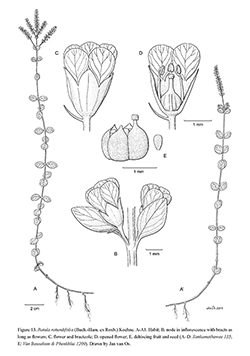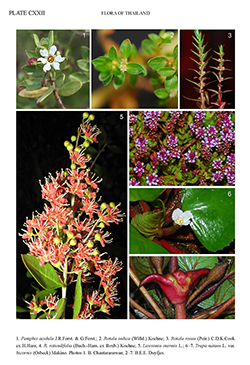e-Flora of Thailand
Volume 11 > Part 4 > Year 2014 > Page 590 > Lythraceae > Rotala
5. Rotala rotundifolia (Buch.-Ham. ex Roxb.) Koehnewfo-0001076077
Bot. Jahrb. Syst. 1(2): 175. 1880; Pflanzenr. IV. 216 (Heft 17): 41. 1903; Gagnep., Fl. Indo-Chine [P.H.Lecomte et al.] 2: 973, f. 106: 1–4. 1921; Craib, Fl. Siam. 1: 717. 1931; C.D.K.Cook, Boissiera 29: 49, f. 9: A–D, map 5. 1979; P.H.Hô, Ill. Fl. Vietnam 2(1): 33, f. 3688. 1992; T.C.Huang, Fl. Taiwan, ed. 2. 3: 883, pl. 439. 1993; H.N.Qin & S.A.Graham, Fl. China 13: 285. 2007; H.N.Qin, S.A.Graham & M.G.Gilbert, Fl. China Ill. 13: f. 302: 8–11. 2008.— Ammannia rotundifolia Buch.-Ham. ex Roxb., Fl. Ind. (Carey & Wallich ed.) 1: 446. 1820. Fig. 13. Plate CXXII: 4.
Accepted Name : This is currently accepted.
Synonyms & Citations :
Description : Amphibious perennial herbs, stem ± succulent, green or red, at base decumbent, creeping or floating, or tufted, branched, to 40 cm tall, 4(–6)-angled towards the apex. Leaves decussate, sessile or short petiolate; lamina obovate to orbicular, to 2 cm long, 2.5 cm wide (submerged leaves linear to orbicular), red or purple on lower surface, nerves distinct, pinnate, green, white or red. Bracts ovate, 1–4 mm long; bracteoles linear to lanceolate, ca 1 mm long, about as long as calyx tube, membranous. Flowers subsessile, solitary in axils of bracts; inflorescence usually a terminal many-flowered pedunculate raceme, dense at early anthesis, elongate, lax (stem visible between the nodes) in fruit; calyx green or purplish, calyx tube campanulate ca 1 mm long, membranous, with 4 rib-like nerves; calyx lobes triangular, to 1 mm long; calyx appendages or folds absent; petals pink, 4, obovate, 2 to 3 times as long as calyx lobes; stamens 4; filaments inserted near base of calyx tube, ca 1.5 mm long, anthers level with middle of calyx lobes; ovary globose; style to 0.5 mm long; stigma peltate, ca 0.3 mm diam., level with anthers. Capsules globose, ca 1.5 mm diam., opening by 4 valves. Seeds half-ellipsoid, ca 0.5 mm long.
Thailand : NORTHERN: Chiang Mai (Doi Ang Khang, Doi Suthep, Doi Suthep-Pui NP, Bo Luang, Omkoi, Mae Wang, Samoeng, Mae Taeng, Mai Mueang Nao Arboretum, Ban Nong Keo); Chiang Rai (Ban Lang Lat); EASTERN: Chaiyaphum (Thung Kramang).
Distribution : India (type), Bangladesh, Nepal, Myanmar, Laos, Vietnam, China (Yunnan), Japan, Taiwan.
Ecology : Moist localities such as boggy places in dry dipterocarp forests, poor sandy soils, paddy fields, in mud-bottom drainage ditches, marshy edges of ponds, and moist savanna over clayey soil; granite bedrock; 550–1,300 m alt. Flowering and fruiting: November–June.
Uses: Cultivated as an ornamental marsh herb in paludaria and along ponds.


